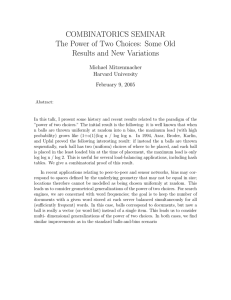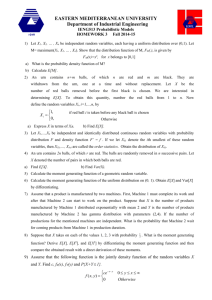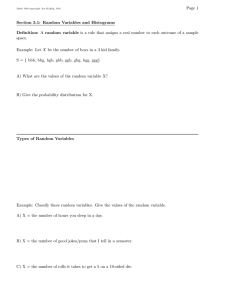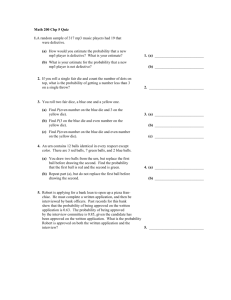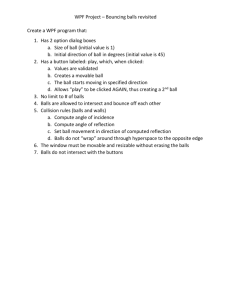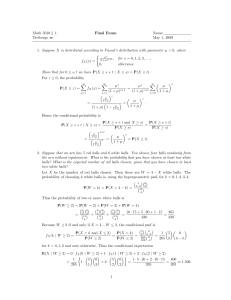Math 5010 § 1. Solutions to tenth Homework Treibergs March 27, 2009
advertisement
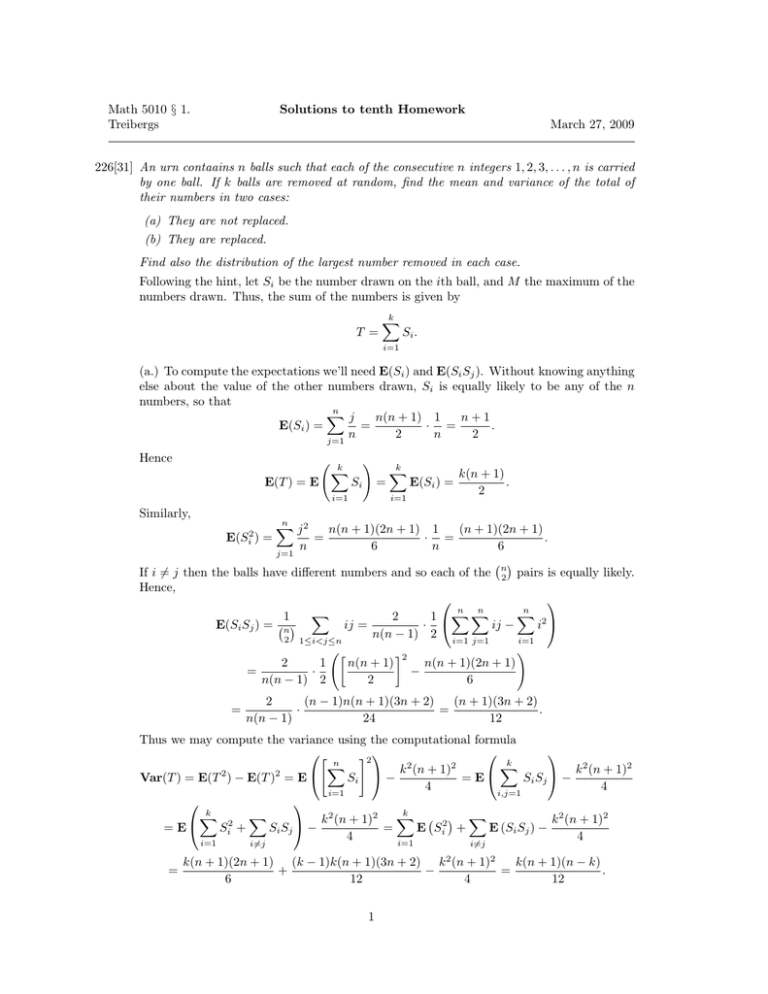
Math 5010 § 1.
Treibergs
Solutions to tenth Homework
March 27, 2009
226[31] An urn contaains n balls such that each of the consecutive n integers 1, 2, 3, . . . , n is carried
by one ball. If k balls are removed at random, find the mean and variance of the total of
their numbers in two cases:
(a) They are not replaced.
(b) They are replaced.
Find also the distribution of the largest number removed in each case.
Following the hint, let Si be the number drawn on the ith ball, and M the maximum of the
numbers drawn. Thus, the sum of the numbers is given by
T =
k
X
Si .
i=1
(a.) To compute the expectations we’ll need E(Si ) and E(Si Sj ). Without knowing anything
else about the value of the other numbers drawn, Si is equally likely to be any of the n
numbers, so that
n
X
j
n(n + 1) 1
n+1
E(Si ) =
=
· =
.
n
2
n
2
j=1
Hence
E(T ) = E
k
X
!
Si
=
i=1
k
X
E(Si ) =
i=1
k(n + 1)
.
2
Similarly,
n
X
j2
n(n + 1)(2n + 1) 1
(n + 1)(2n + 1)
· =
.
6
n
6
j=1
If i 6= j then the balls have different numbers and so each of the n2 pairs is equally likely.
Hence,
n
n
n
X
X
2
1 X X
1
ij =
ij −
i2
·
E(Si Sj ) = n
n(n
−
1)
2
2 1≤i<j≤n
i=1
i=1 j=1
!
2
2
1
n(n + 1)
n(n + 1)(2n + 1)
=
·
−
n(n − 1) 2
2
6
E(Si2 ) =
=
n
=
(n − 1)n(n + 1)(3n + 2)
(n + 1)(3n + 2)
2
·
=
.
n(n − 1)
24
12
Thus we may compute the variance using the computational formula
"
#2
n
k
2
2
X
X
k 2 (n + 1)2
k (n + 1)
= E
Si Sj −
Var(T ) = E(T 2 ) − E(T )2 = E
Si −
4
4
i,j=1
i=1
k
k
X
X
X
X
k 2 (n + 1)2
k 2 (n + 1)2
= E
Si2 +
Si Sj −
=
E Si2 +
E (Si Sj ) −
4
4
i=1
i=1
i6=j
i6=j
2
=
k(n + 1)(2n + 1) (k − 1)k(n + 1)(3n + 2) k (n + 1)2
k(n + 1)(n − k)
+
−
=
.
6
12
4
12
1
To get the pmf for M = max{S1 , . . . , Sk }, we observe that the cumulative distribution
function
FM (m) = P(M ≤ m) = P(Si ≤ m for all 1 ≤ i ≤ k).
Since all the subsets of k are equally likely, the probability is just gotten by counting the
number of subsets in {1, 2, 3, . . . , m}. Thus
m
k
FM (m) = n .
k
It follows from Pascal’s triangle that for k ≤ m ≤ n,
m
k
n
k
fM (m) = FM (m) − FM (m − 1) =
−
m−1
k
n
k
=
m−1
k−1
n
k
.
(b.) Now assume that the draws are made with replacement so now the draws are independent uniform variables. Si is equally likely to be any of the n numbers, so that
E(Si ) =
n
X
j
n(n + 1) 1
n+1
=
· =
.
n
2
n
2
j=1
Hence, again,
E(T ) = E
k
X
!
Si
=
i=1
k
X
E(Si ) =
i=1
k(n + 1)
.
2
Similarly,
E(Si2 ) =
n
X
j2
j=1
n
=
n(n + 1)(2n + 1) 1
(n + 1)(2n + 1)
· =
.
6
n
6
If i 6= j then by independence,
E(Si Sj ) = E(Si ) E(Sj ) =
(n + 1)2
.
4
Thus we may compute the variance using the computational formula
"
#2
n
k
2
2
X
X
k
(n
+
1)
k 2 (n + 1)2
Var(T ) = E(T 2 ) − E(T )2 = E
Si −
= E
Si Sj −
4
4
i=1
i,j=1
k
n
X
X
X
X
k 2 (n + 1)2
k 2 (n + 1)2
= E
Si2 +
Si Sj −
=
E Si2 +
E (Si Sj ) −
4
4
i=1
i=1
i6=j
i6=j
2
=
2
k(n + 1)(2n + 1) k(k − 1)(n + 1)
k (n + 1)2
k(n − 1)(n + 1)
+
−
=
.
6
4
4
12
Of course this is just the formula for the variance of a sum for independent variables
!
k
k
X
X
k(n2 − 1)
Var(T ) = Var
Si =
Var(Si ) =
.
12
i=1
i=1
To get the pmf for M = max{S1 , . . . , Sk }, we observe that the cumulative distribution
function
FM (m) = P(M ≤ m) = P(Si ≤ m for all 1 ≤ i ≤ k).
2
By independence, the probability is just gotten by multiplying the P(Si ≤ m). Thus
m k
.
FM (m) =
n
It follows that for 1 ≤ m ≤ n,
fM (m) = FM (m) − FM (m − 1) =
m
n
k
−
m−1
n
k
.
226[36] An urn contains m white balls and M − m black balls. n ≤ M balls are chosen at random
without replacement. Let X denote the number of white balls among these. Show that the
probability that there are exactly k white balls, 0 ≤ k ≤ m is given by
m M −m
fX (k) = P(X = k) =
k
n−k
M
n
.
Show that X = I1 + · · · + In where Ii = 0 or 1 according to whether or not the ith ball is
black or white. Show that for i 6= j,
P(Ii = 1) =
m
,
M
P(Ii = 1 and Ij = 1) =
m(m − 1)
.
M (M − 1)
By computing E(X) and E(X 2 ) or otherwise, find the mean and variance of X. [In other
words, given a hypergeometric variable X ∼ hyp(M, m, n), use the method of indicators to
derive the mean and variance of X.]
Pn
Ii = 1 exactly when the ith ball is white, so that i=1 Ii is the number of white balls chosen.
Knowing nothing else about the other Ij , by symmetry E(Ii ) = P(ith ball is white) =
P(first ball is white) = E(I1 ). Since each choice of the first ballis equally likely,
E(Ii2 ) = E(Ii ) = E(I1 ) =
m
.
M
since Ii2 = Ii . Similarly, by symmetry, the chances of both the ith and jth balls being white
is the same as the first two drawn being white. Thus, for i 6= j,
E(Ii Ij ) = P(Ii = 1 and Ij = 1) = P(I1 = 1 and I2 = 1)
= P(Ii = 1) P(I2 = 1 | I1 = 1) =
m(m − 1)
.
M (M − 1)
Now, by linearity,
E(X) = E
n
X
!
Ii
=
i=1
n
X
i=1
E(Ii ) =
mn
.
M
Similarly,
"
E(X 2 ) = E
n
X
#2
n
n
X
X
X
Ii = E
Ii Ij = E
Ii2 +
Ii Ij
i=1
=
n
X
i,j=1
E(Ii2 ) +
i=1
X
E(Ii Ij ) =
i6=j
i=1
i6=j
mn n(n − 1)m(m − 1)
+
.
M
M (M − 1)
Finally,
Var(X) = E(X 2 ) − E(X)2 =
mn n(n − 1)m(m − 1) m2 n2
m(M − m)n(M − n)
+
−
=
.
M
M (M − 1)
M2
M 2 (M − 1)
3
[A.] N people arrive separately to a professional dinner. Upon arrival, each person looks to see if
he or she has any friends among those present. That person then sits at a table of a friend,
orat an unoccupied table if none of those present is a friend. Assuming that each of the
n
2 pairs of people are, independently, friends with probability p, find the expected number
of occupied tables. [S. Ross, “A First Course in Probability,” Ch. 7 Prob. 8.]
According to the hint, using the method of indicators, we let Ii = 1 or 0 according to
whether or not the ith arrival sits at a previously unoccupied table. Then the number of
occupied tables is X = I1 + · · · + In . Since noone else has arrived when the first person
arrives, always I1 = 1 so E(Ii ) = 1. For i ≥ 2, there are i − 1 people present, so that the
probability that none of them is a friend of i is, by independence, q i−1 . Thus
E(Ii ) = P(Ii = 1) = q i−1 .
This holds for i = 1 also. Thus the expectation
!
n
n
n
X
X
X
1 − qn
1 − qn
=
.
Ii =
E(X) = E
E(Ii ) =
q i−1 =
1−q
p
i=1
i=1
i=1
Note that 0 < E(Ii ) < 1 for i ≥ 2 so 1 < E(X) < n, as we would expect with n ≥ 2 arrivals.
4

